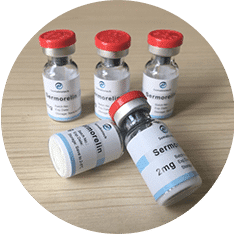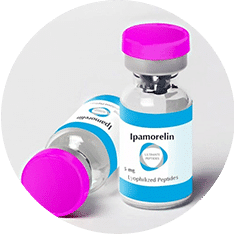
Unlock a More Youthful You With Hormone Replacemment Therapy In Hackensack, NJ
Aging is inevitable, and for many, it signals the beginning of a new chapter - one where you cross off bucket list items and live life to the fullest, on your own terms. However, for some women, aging is a horrible prospect, filled with chronic fatigue, irritability, and inability to perform in the bedroom. If you're concerned about life in middle age and beyond, we've got great news: there are easy, proven steps that you can take to help stop the negative effect of aging.
Global Life Rejuvenation was founded to give women a new lease on life - one that includes less body fat, fewer mood swings, and more energy as you age. If you're ready to look and feel younger, it's time to consider HRT (hormone replacement therapy), and growth hormone peptides. These therapies for men and women are effective, safe, and customized to fit your goals, so you can keep loving life as you get older.
HRT, and growth hormone peptide therapies bridge the gap between your old life and the more vibrant, happier version of you. With a simple click or call, you can be well on your way to a brighter future. After all, you deserve to be the one in charge of your wellness and health. Now, you have the tools to do so - backed by science and applied by our team of HRT experts with more than 13 years of experience.
What is HRT?
As women age, their hormones begin to go through changes that affect their day-to-day lives. For women, hormone deficiency and imbalance usually occur during menopause and can cause chronic fatigue, hot flashes, and mood swings, among other issues. Hormone replacement therapy helps correct hormone imbalances in women, helping them feel more vibrant and virile as they age.
Often, HRT treatments give patients enhanced quality of life that they didn't think was possible - even in their 60's and beyond.
The benefits for women are numerous and are available today through Global Life Rejuvenation.
HORMONE REPLACEMENT THERAPY
HRT and Anti-Aging Medicine for Women in Hackensack, NJ
As women age, their bodies begin to go through significant changes that affect their quality of life. This change is called menopause and marks the end of a woman's menstrual cycle and reproduction ability. Though there is no specific age when this change occurs, the average age of menopause onset is 51 years old. However, according to doctors, menopause officially starts 12 months after a woman's final period. During the transition to menopause, women's estrogen and other hormones begin to deplete.
As that happens, many women experience severe symptoms. These symptoms include:
- Hot Flashes
- Chronic Fatigue
- Incontinence
- Trouble Sleeping
- Dryness
- Muscle Loss
- Fat Gain
- Mood Swings
The symptoms of hormone deficiency can be concerning and scary for both women and their spouses. However, if you're getting older and notice some of these symptoms, there is reason to be hopeful. Hormone replacement therapy and anti-aging medicine for women can correct imbalances that happen during menopause. These safe, effective treatments leave you feeling younger, healthier, and more vibrant.


What Causes Menopause?
The most common reason for menopause is the natural decline in a female's reproductive hormones. However, menopause can also result from the following situations:
Oophorectomy: This surgery, which removes a woman's ovaries, causes immediate menopause. Symptoms and signs of menopause in this situation can be severe, as the hormonal changes happen abruptly.
Chemotherapy: Cancer treatments like chemotherapy can induce menopause quickly, causing symptoms to appear shortly after or even during treatment.
Ovarian Insufficiency: Also called premature ovarian failure, this condition is essentially premature menopause. It happens when a woman's ovaries quit functioning before the age of 40 and can stem from genetic factors and disease. Only 1% of women suffer from premature menopause, but HRT can help protect the heart, brain, and bones.
Common Issues for Women During Menopause
For many women, menopause is a trying time that can be filled with many hormonal hurdles to jump through. A little knowledge can go a long way, whether you're going through menopause now or are approaching "that" age.
Here are some of the most common issues that women experience during menopause:

Depression
If you're a woman going through menopause and find that you have become increasingly depressed, you're not alone. It's estimated that 15% of women experience depression to some degree while going through menopause. What many women don't know is that depression can start during perimenopause, or the years leading up to menopause.
Depression can be hard to diagnose, especially during perimenopause and menopause. However, if you notice the following signs, it might be time to speak with a physician:
- Mood Swings
- Inappropriate Guilt
- Chronic Fatigue
- Too Much or Too Little Sleep
- Lack of Interest in Life
- Overwhelming Feelings
Remember, if you're experiencing depression, you're not weak or broken - you're going through a very regular emotional experience. The good news is that with proper treatment from your doctor, depression isn't a death sentence. And with HRT and anti-aging treatment for women, depression could be the catalyst you need to enjoy a new lease on life.

Hot Flashes
Hot flashes - they're one of the most well-known symptoms of menopause. Hot flashes are intense, sudden feelings of heat across a woman's upper body. Some last second, while others last minutes, making them incredibly inconvenient and uncomfortable for most women.
Symptoms of hot flashes include:
- Sudden, Overwhelming Feeling of Heat
- Anxiety
- High Heart Rate
- Headache
- Nausea
- Dizziness
Typically, hot flashes are caused by a lack of estrogen. Low estrogen levels negatively affect a woman's hypothalamus, the part of the brain that controls body temperature and appetite. Low estrogen levels cause the hypothalamus to incorrectly assume the body is too hot, dilating blood vessels to increase blood flow. Luckily, most women don't have to settle for the uncomfortable feelings that hot flashes cause. HRT treatments for women often stabilize hormones, lessening the effects of hot flashes and menopause in general.

Mood Swings
Mood swings are common occurrences for most people - quick shifts from happy to angry and back again, triggered by a specific event. And while many people experience mood swings, they are particularly common for women going through menopause. That's because, during menopause, the female's hormones are often imbalanced. Hormone imbalances and mood swings go hand-in-hand, resulting in frequent mood changes and even symptoms like insomnia.
The rate of production of estrogen, a hormone that fluctuates during menopause, largely determines the rate of production the hormone serotonin, which regulates mood, causing mood swings.
Luckily, HRT and anti-aging treatments in Hackensack, NJ for women work wonders for mood swings by regulating hormone levels like estrogen. With normal hormone levels, women around the world are now learning that they don't have to settle for mood swings during menopause.

Weight Gain
Staying fit and healthy is hard for anyone living in modern America. However, for women with hormone imbalances during perimenopause or menopause, weight gain is even more serious. Luckily, HRT treatments for women coupled with a physician-led diet can help keep weight in check. But which hormones need to be regulated?
- Estrogen: During menopause, estrogen levels are depleted. As such, the body must search for other sources of estrogen. Because estrogen is stored in fat, your body believes it should increase fat production during menopause. Estrogen also plays a big part in insulin resistance, which can make it even harder to lose weight and keep it off.
- Progesterone: Progesterone levels are also depleted during menopause. Progesterone depletion causes bloating and water retention, while loss of testosterone limits the body's ability to burn calories.
- Ongoing Stress: Stress makes our bodies think that food is hard to come by, putting our bodies in "survival mode". When this happens, cortisol production is altered. When cortisol timing changes, the energy in the bloodstream is diverted toward making fat. With chronic stress, this process repeatedly happens, causing extensive weight gain during menopause.

Low Libido
Lowered sexual desire - three words most men and women hate to hear. Unfortunately, for many women in perimenopausal and menopausal states, it's just a reality of life. Thankfully, today, HRT and anti-aging treatments Hackensack, NJ can help women maintain a normal, healthy sex drive. But what causes low libido in women, especially as they get older?
The hormones responsible for low libido in women are progesterone, estrogen, and testosterone.
Progesterone production decreases during perimenopause, causing low sex drive in women. Lower progesterone production can also cause chronic fatigue, weight gain, and other symptoms. On the other hand, lower estrogen levels during menopause lead to vaginal dryness and even vaginal atrophy or loss of muscle tension.
Lastly, testosterone plays a role in lowered libido. And while testosterone is often grouped as a male hormone, it contributes to important health and regulatory functionality in women. A woman's testosterone serves to heighten sexual responses and enhances orgasms. When the ovaries are unable to produce sufficient levels of testosterone, it often results in a lowered sex drive.

Vaginal Dryness
Often uncomfortable and even painful, vaginal dryness is a serious problem for sexually active women. However, like hair loss in males, vaginal dryness is very common - almost 50% of women suffer from it during menopause.
Getting older is just a part of life, but that doesn't mean you have to settle for the side effects. HRT and anti-aging treatments for women correct vaginal dryness by re-balancing estrogen, progesterone, and testosterone. When supplemented with diet and healthy living, your vagina's secretions are normalized, causing discomfort to recede.

Fibroids
Uterine fibroids - they're perhaps the least-known symptom of menopause and hormone imbalances in women. That's because these growths on the uterus are often symptom-free. Unfortunately, these growths can be cancerous, presenting a danger for women as they age.
Many women will have fibroids at some point. Because they're symptomless, they're usually found during routine doctor exams. Some women only get one or two, while others may have large clusters of fibroids. Because fibroids are usually caused by hormone imbalances, hysterectomies have been used as a solution, forcing women into early menopause.
Advances in HRT and anti-aging medicine for women give females a safer, non-surgical option without having to experience menopause early. At Global Life Rejuvenation, our expert physicians will implement a customized HRT program to stabilize your hormones and reduce the risk of cancerous fibroid growth.

Endometriosis
Endometriosis symptoms are much like the effects of PMS, and include pelvic pain, fatigue, cramping, and bloating. While doctors aren't entirely sure what causes this painful, uncomfortable condition, most agree that hormones - particularly xenoestrogens - play a factor.
Endometriosis symptoms are much like the effects of PMS and include pelvic pain, fatigue, cramping, and bloating. While doctors aren't entirely sure what causes this painful, uncomfortable condition, most agree that hormones - particularly xenoestrogens - play a factor.
Xenoestrogen is a hormone that is very similar to estrogen. Too much xenoestrogen is thought to stimulate endometrial tissue growth. HRT for women helps balance these hormones and, when used with a custom nutrition program, can provide relief for women across the U.S.
Is HRT for Women the Right Answer?
Hormone stability is imperative for a healthy sex drive and for a normal, stress-free life during menopause. HRT and anti-aging treatments for women balance the hormones that your body has altered due to perimenopause or menopause.
HRT for women is a revolutionary step in helping women live their best lives, even as they grow older. However, at Global Life Rejuvenation, we know that no two patients are the same. That's why we specialize in holistic treatments that utilize HRT, combined with healthy nutrition, supplements, and fitness plans that maximize hormone replacement treatments.
If you've been suffering through menopause, is HRT the answer? That's hard to say without an examination by a trusted physician, but one thing's for sure. When a woman balances her hormone levels, she has a much better shot at living a regular life with limited depression, weight gain, mood swings, and hot flashes.
Here are just a few additional benefits of HRT and anti-aging treatments for females:


Benefits of HRT and Anti-Aging Medicine for Women in Hackensack, NJ
Hormone imbalance causes a litany of issues. But with anti-aging treatments for women, females can better process calcium, keep their cholesterol levels safe, and maintain a healthy vagina. By replenishing the body's estrogen supply, HRT can relieve symptoms from menopause and protect against osteoporosis. But that's just the start.
Global Life Rejuvenation's patients report many more benefits of HRT and anti-aging medicine for women:
- Fewer Mood Swings
- Thicker Hair
- Stronger Bones
- Less Body Fat
- More Energy
- More Stamina
- Increased Sex Drive and Pleasure Sensations
- Better Cognitive Functions
- Improved Pain Receptors
- Less Hot Flashes and Night Sweats
- Lower Triglycerides
- Fewer Bladder Infections
If you're ready to feel better, look better, and recapture the vitality of your youth, it's time to contact Global Life Rejuvenation. It all starts with an in-depth consultation, where we will determine if HRT and anti-aging treatments for women are right for you. After all, every patient's body and hormone levels are different. Since all our treatment options are personalized, we do not have a single threshold for treatment. Instead, we look at our patient's hormone levels and analyze them on a case-by-case basis.

HRT from Global Life Rejuvenation
At Global Life Rejuvenation, we help women rediscover their youth with HRT treatment for women. We like to think of ourselves as an anti-aging concierge service, guiding and connecting our patients to the most qualified HRT physicians available. With customized HRT treatment plan for women, our patients experience fewer menopausal symptoms, less perimenopause & menopause depression, and often enjoy a more youth-like appearance.
Reverse Aging with Growth Hormone Peptides
Growth hormone peptides are an innovative therapy that boosts the natural human growth hormone production in a person's body. These exciting treatment options help slow down the aging process and give you a chance at restoring your youth.

What is Sermorelin?
Sermorelin is a synthetic hormone peptide, like GHRH, which triggers the release of growth hormones. When used under the care of a qualified physician, Sermorelin can help you lose weight, increase your energy levels, and help you feel much younger.

Benefits of Sermorelin
Human growth hormone (HGH) therapy has been used for years to treat hormone deficiencies. Unlike HGH, which directly replaces declining human growth hormone levels, Sermorelin addresses the underlying cause of decreased HGH, stimulating the pituitary gland naturally. This approach keeps the mechanisms of growth hormone production active.
- Benefits of Sermorelin include:
- Better Immune Function
- Improved Physical Performance
- More Growth Hormone Production
- Less Body Fat
- Build More Lean Muscle
- Better Sleep

What is Ipamorelin?
Ipamorelin helps to release growth hormones in a person's body by mimicking a peptide called ghrelin. Ghrelin is one of three hormones which work together to regulate the growth hormone levels released by the pituitary gland. Because Ipamorelin stimulates the body to produce growth hormone, your body won't stop its natural growth hormone production, which occurs with synthetic HGH.
Ipamorelin causes growth hormone secretion that resembles natural release patterns rather than being constantly elevated from HGH. Because ipamorelin stimulates the natural production of growth hormone, our patients can use this treatment long-term with fewer health risks.

Benefits of Ipamorelin
One of the biggest benefits of Ipamorelin is that it provides significant short and long-term benefits in age management therapies. Ipamorelin can boost a patient's overall health, wellbeing, and outlook on life.
When there is an increased concentration of growth hormone by the pituitary gland, there are positive benefits to the body. Some benefits include:
- Powerful Anti-Aging Properties
- More Muscle Mass
- Less Unsightly Body Fat
- Deep, Restful Sleep
- Increased Athletic Performance
- More Energy
- Less Recovery Time for Training Sessions and Injuries
- Enhanced Overall Wellness and Health
- No Significant Increase in Cortisol
Your New, Youthful Lease on Life with HRT for Women
Whether you are considering our HRT and anti-aging treatments for women in Hackensack, NJ, we are here to help. The first step to reclaiming your life begins by contacting Global Life Rejuvenation. Our friendly, knowledgeable HRT experts can help answer your questions and walk you through our procedures. From there, we'll figure out which treatments are right for you. Before you know it, you'll be well on your way to looking and feeling better than you have in years!
 866-793-9933
866-793-9933
Request a Consultation
Latest News in Hackensack, NJ
Plan for large apartment building, retail across from train station in Hackensack advances
North Jersey Media Grouphttps://www.northjersey.com/story/news/bergen/hackensack/2024/04/18/new-hackensack-nj-building-include-350-units-retail-space/73347771007/
Megan BurrowHACKENSACK — Plans for a large apartment building at the corner of Anderson and Linden streets are moving forward with an additional 30 units proposed for a mixed-use development at the site.The City Council amended a redevelopment plan for the 2.7-acre site at 123 Anderson Street last month to include 350 apartments, with retail space on the first floor. The amended ...
HACKENSACK — Plans for a large apartment building at the corner of Anderson and Linden streets are moving forward with an additional 30 units proposed for a mixed-use development at the site.
The City Council amended a redevelopment plan for the 2.7-acre site at 123 Anderson Street last month to include 350 apartments, with retail space on the first floor. The amended plan also includes 20 public parking spaces. The developer would pay 1.5% of the property’s value in development fees into the city’s affordable housing trust fund as part of Hackensack’s settlement with Fair Share Housing Center, city officials said.
The building would replace a Walgreens pharmacy, several other storefronts, two smaller buildings and a parking lot across the street from the train station.
The street, a short commercial strip with a mix of restaurants, hair and nail salons, convenience stores and older apartment buildings and anchored by the Anderson Street Train Station, is undergoing changes, as Main Street just to the east, is in the midst of widespread redevelopment.
A six-story, 222-unit apartment building is under construction just down the street from the proposed development, at the former site of the longtime restaurant Rudy's and the city's former Building Department.
This is the third year of a five-year state grant program to improve the neighborhood with outdoor seating, lighting, trash cans, traffic-calming crosswalks and money for businesses to upgrade their storefronts.
“The area needs to be redeveloped. We’re going to start building up Anderson Street,” Mayor John Labrosse said. “It will be up to a developer to come up with an idea that works for the city and the residents in that area.”
Some residents have voiced concerns about a largescale apartment building at that corner, just off a residential neighborhood.
Brigitte Rucker said she’s concerned the development would bring more traffic to an area that already gets backed up when a train comes in.
“Let the community be part of the conversation. Why can’t they create a forum where the community can speak, especially those that live in that area,” she said. “We don’t need another apartment building. Putting that building there you’ll be taking away from the beauty and culture of the neighborhood.”
City officials said the public will have an opportunity to weigh in when plans come before the city Planning Board. Traffic and infrastructure are part of every evaluation of a potential development, they said.
“Most of the businesses there have already closed. It’s an area that’s certainly not bringing additional revenue to the city in any way to help with taxes. It’s really become an eyesore,” Deputy Mayor Kathy Canestrino said at a council meeting earlier this month. “We all have to get our heads together and look at what makes the most sense there. The area has already been developed with apartment units. It makes sense with the proximity to the train station.”
Hackensack Girl Scouts Go for the Gold Promoting Sisterhood
Rebecca Greenehttps://www.tapinto.net/towns/hackensack/sections/arts-and-entertainment/articles/hackensack-girl-scouts-go-for-the-gold-promoting-sisterhood
HACKENSACK, NJ - Four senior Girl Scouts from Hackensack and surrounding communities are making it their mission to promote sisterhood on their way to their Gold Award Project, the concluding project for senior Girl Scouts.Sylvia Brown (Hackensack), Safiya Mannan (Hackensack), Halle Palmer (Teaneck), and Zuri Thorn (Maywood), recently shared their sisterhood joy with younger Scouts, according to Jennylyn Brown, one of their troop leaders.As part of their Mission Sisterhood Journey on the way to their Gold Award Project, the you...
HACKENSACK, NJ - Four senior Girl Scouts from Hackensack and surrounding communities are making it their mission to promote sisterhood on their way to their Gold Award Project, the concluding project for senior Girl Scouts.
Sylvia Brown (Hackensack), Safiya Mannan (Hackensack), Halle Palmer (Teaneck), and Zuri Thorn (Maywood), recently shared their sisterhood joy with younger Scouts, according to Jennylyn Brown, one of their troop leaders.
As part of their Mission Sisterhood Journey on the way to their Gold Award Project, the young ladies undertook the Take Action Project by visiting five younger Brownies and Junior troops to present the meaning of Sisterhood, why it is essential, and how to practice it, Brown said.
Sign Up for FREE Hackensack Newsletter
Get local news you can trust in your inbox.
This site is protected by reCAPTCHA and the Google Privacy Policy and Terms of Service apply.
They presented to 50 younger Girl Scouts at their troop meetings and had them participate in activity stations, including handprints on canvas, Sisterhood word art, and recording a video on what Sisterhood means to them.
After completing the presentations to the troop, the Gold Award Candidates hosted a Sisterhood Fair at the Maywood Senior Center on Saturday, April 27, Brown said. All the troops they visited were invited to come together for an afternoon of fun and activities. With 25 girls in attendance, they shared the video they produced from the individual recording, a slide show of photographs from the meetings, and an exhibit of the word art.
They played games, such as Sisterhood Bingo, 'pin the patch on the vest', musical chairs, and freeze dance. The hand-printed canvas was used as a photo backdrop.
"All the Scouts could see what the individual troops thought of Sisterhood," Brown said.
"It was a successful Take Action Project; everyone had fun and acquired new skills. The Girl Scout senior learned skills from planning and project management, working with younger groups, presenting and public speaking, time management, and prioritization of tasks," she said.
"The delegation of duties and asking for help and support from your extended community were also important lessons learned."
The next project for the Gold Award candidates? "Girltopia."
"Girl Scout Seniors know the world could be better, especially for their female counterparts," Brown said. "This Journey and Take Action Project is their chance to imagine a perfect world—for girls. After completing that Journey and Take Action, they will individually plan and work on their Gold Award Project.
The Girl Scout Gold Award is the highest Award a Girl Scout can achieve; it requires at least 80 hours of work and must be an individual project that implements a long-term solution to a community issue. Many compare it to the Boy Scout Eagle Award.
Hackensack Elks Recognize Youth Leaders
REBECCA GREENEhttps://www.tapinto.net/towns/hackensack/sections/giving-back/articles/hackensack-elks-recognize-youth-leaders
Hackensack Elks Lodge #658: One standout recipient of this year's awards was Dallas Pettway, who took first place in the 10-11 girls Hoop Shoot Contest at the lodge, district, and state levels. Dallas went on to place third at the Northeast Regional Competition, showcasing her exceptional talent and dedication to the sport.Photo Credit: Hackensack Elks LodgeHackensack Elks Lodge #658: One standout recipient of this year's awards was Dallas Pettway, who took first place in the 10-11 girls Hoop Shoot Cont...
Hackensack Elks Lodge #658: One standout recipient of this year's awards was Dallas Pettway, who took first place in the 10-11 girls Hoop Shoot Contest at the lodge, district, and state levels. Dallas went on to place third at the Northeast Regional Competition, showcasing her exceptional talent and dedication to the sport.
Photo Credit: Hackensack Elks Lodge
Hackensack Elks Lodge #658: One standout recipient of this year's awards was Dallas Pettway, who took first place in the 10-11 girls Hoop Shoot Contest at the lodge, district, and state levels. Dallas went on to place third at the Northeast Regional Competition, showcasing her exceptional talent and dedication to the sport.Photo Credit: Hackensack Elks Lodge #658
Youth Breakfast Awards, Hackensack Elks Lodge: April 20, 2024Photo Credit: Hackensack Elks Lodge
By Jamie England - Hackensack Elks Lodge #658
PublishedApril 29, 2024 at 2:00 PM
HACKENSACK, NJ - Several local youth were recognized for their community achievements during the annual breakfast hosted by the Benevolent and Protective Order of Elks.
On Saturday, April 20, the Benevolent and Protective Order of Elks, Hackensack Lodge #658, held their Annual Youth Awards Breakfast to recognize the outstanding achievements of local youth in the community. The event honored the first, second, and third place winners of each age group for the Soccer Shoot and Hoop Shoot competitions. In addition, the lodge proudly celebrated the recipient of the $4,000 Most Valuable Student Scholarship.
The attendees were treated to a delicious breakfast prepared by members of the Hackensack Elks, and served by the members of the Hackensack Antler Lodge #27. The Hackensack Antler Program, open to individuals ages 12-20, provides a unique opportunity for young people to become actively engaged in their community while building essential skills such as leadership, teamwork, and problem-solving.
One standout recipient of this year's awards was Dallas Pettway, who took first place in the 10-11 girls Hoop Shoot Contest at the lodge, district, and state levels. Dallas went on to place third at the Northeast Regional Competition, showcasing her exceptional talent and dedication to the sport.
The Hackensack Elks Lodge #658, established in 1901, has a long history of charitable work and community involvement. From supporting food pantries and awarding scholarships to sponsoring youth programs and hosting leadership initiatives, the Elks are dedicated to promoting the four cardinal virtues of charity, justice, brotherly love, and fidelity.
For more information on the Hackensack Elks Lodge #658 and their community initiatives, visit https://www.facebook.com/hackensackelks.
Former Hackensack bank stands where the tavern that fed Gen. Washington once stood
David M. Zimmerhttps://www.northjersey.com/story/news/bergen/hackensack/2024/03/09/visit-hackensack-nj-corner-where-revolutionary-war-history-was-made/72523933007/
Opposite the northwest corner of the Hackensack Green, a 150-year-old former bank stands on hallowed ground.Now housing law offices, the former Bank of Bergen County was built in 1874 as a monument to the county's prosperity. Gleaming in bright red brick, the building was a refreshing example of Victorian Gothic architecture and a display of Hackensack's wealth.Today, it endures as a reminder of an even deeper history. It serves as a bridge to a time when the site at the corner of what is now Sussex and Main streets held Archib...
Opposite the northwest corner of the Hackensack Green, a 150-year-old former bank stands on hallowed ground.
Now housing law offices, the former Bank of Bergen County was built in 1874 as a monument to the county's prosperity. Gleaming in bright red brick, the building was a refreshing example of Victorian Gothic architecture and a display of Hackensack's wealth.
Today, it endures as a reminder of an even deeper history. It serves as a bridge to a time when the site at the corner of what is now Sussex and Main streets held Archibald Campbell's tavern that fed Gen. George Washington during the retreat that made a nation.
It was about dusk when the first of the troops entered Hackensack on Nov. 20, 1776, according to an eyewitness account once kept by the Rev. Theodore B. Romeyn, the mid-19th century pastor of the First Church of Hackensack. They were falling back from a series of disasters that had British generals salivating at the prospects of victory.
"The night was dark, cold and rainy," the account continues. "They marched two abreast, looked ragged, some without a shoe to their feet, and most of them wrapped up in their blankets."
For the previous 18 months, Bergen County had become increasingly involved in the Revolution. The county had been war-torn, trounced by both Patriots and Loyalists seeking to gain key footholds in the conflict.
The drums of battle would beat again after the loss of Fort Washington in Harlem Heights on Nov. 16, 1776. Within four days, 5,000 British and Hessian troops were advancing up the Palisades toward an exposed Fort Lee. The fall of Fort Lee on Nov. 20 added to a string of Patriot mishaps in Long Island, Brooklyn and White Plains, New York.
Washington wrote to Gen. Charles Lee the next day from Hackensack, informing him of the loss of the "fort called by your name" and his decision to move his troops to the west side of the Hackensack River.
Washington had been staying at Peter Zabriskie's home on the north side of the Green.
Some drunk and mostly weary, Washington's troops had left Fort Lee and marched north to Englewood, then southwest along present-day Lafayette Avenue. From there, they turned right on Forest Avenue until they hit Teaneck Road, then called Schraalenburgh Road. They then proceeded north from there to New Bridge Road, where they turned left and proceeded west, crossing the Hackensack River at the "new bridge."
Washington, the head of his army of roughly 3,000, had crossed the "new bridge" at New Bridge Landing first. His troops trudged behind Washington and stayed at Zabriskie's, 50 Main St. His supplies were furnished by the tavern keeper across the street at 41 Main St., Archibald Campbell. As the British camped across the river, their fires shone brightly - stretching more than a mile. Campbell rightly had his concerns.
Before taking his leave, Washington rode to the dock near the crossing and "viewed the enemy's encampment about 10 or 15 minutes," according to the account.
He then returned to Campbell's tavern for some wine and water. Campbell laid his concerns bare for the general.
"With tears streaming down his face, (Campbell) said, 'General what shall I do? I have a family of small children and a little property here; shall I leave them?' Washington kindly took his hand and replied, 'Mr. Campbell, stay by your family and keep neutral,' then bidding him goodbye, rode off'."
By noon the next day, the British had occupied Hackensack. The Green was packed with thousands of Hessian troops in pursuit of Washington.
On Nov. 30, from New Brunswick, Washington wrote of his thoughts on the British tactics.
“They will pay dearly for it, for I shall continue to retreat before them so as to lull them into security,” he wrote.
More:Former North Jersey home of prominent business minds, treasure hunter listed for $1.5M
In all, Washington's army retreated 90 miles in 19 days before arriving in Trenton. They were there at Christmas in 1776 for the memorable Crossing of the Delaware and victory at Trenton, Washington's first major victory of the war.
For Campbell, the conflict also continued, according to Romeyn's account. His attempts to remain neutral went for naught on the night of March 23, 1780, when an estimated 400 British and Hessian troops burned the former Bergen County Courthouse on the west side of the Green. Campbell was taken prisoner. He had been confined to his bed from a bout of rheumatism and unable to hide when his tavern was raided.
As the story goes, Campbell was able to escape in the confusion and took refuge under the "new bridge." Once it was safe, he returned home. Campbell lived until 1798 and allegedly never had a recurrence of rheumatism.
Best Project Health Care: Hackensack University Medical Center Helena Theurer Pavilion
Jonathan Hillyerhttps://www.enr.com/articles/57554-best-project-health-care-hackensack-university-medical-center-helena-theurer-pavilion
Hackensack, N.J. Submitted by: Blanchard Turner Joint Venture LLC Owner: Hackensack Meridian Health Lead Design Firm: RSC Architects & Page General Contractor: Blanchard Turner JV Civil Engineer: Langan Structural engineer: Reuther Bowman MEP Engineer: Syska-HennessyBuilt on a tight urban site, the 530,000-sq-ft pavilion unites multiple programs and services within a limited floorplate. The nine-story building, which broke ground in January 2018, required 12 enabling...
Hackensack, N.J.
Submitted by: Blanchard Turner Joint Venture LLC
Owner: Hackensack Meridian Health
Lead Design Firm: RSC Architects & Page
General Contractor: Blanchard Turner JV
Civil Engineer: Langan
Structural engineer: Reuther Bowman
MEP Engineer: Syska-Hennessy
Built on a tight urban site, the 530,000-sq-ft pavilion unites multiple programs and services within a limited floorplate. The nine-story building, which broke ground in January 2018, required 12 enabling projects to demolish existing buildings and relocate switchgear, an oxygen farm, boilers and chillers into a new four-story central utility plant across from the hospital. Over four miles of electrical wire were placed within conduits under a roadway to tie the campus together.
The building spans a public roadway and connects to an existing parking garage and four of the hospital’s floors. To make the connections, the team built prefabricated 20-ft-tall by 80-ft-long trusses to create a span. Adding to the challenge, the hospital garage needed to remain accessible during construction, including two entrances directly underneath the work zone area. A 25-ft-deep trench also had to be excavated 6 ft from the 100-year-old existing hospital to create a dedicated lobby to link with the pavilion.
The building’s surgical platform spans several existing structures, requiring a 140-ft-long by 20-ft-tall truss over the hospital pharmacy, which needed to be temporarily relocated. Two stories of a three-story building were demolished to accommodate the truss, requiring a temporary roof to safeguard the electrical equipment on the ground floor.
Photo by Jonathan Hillyer, courtesy Blanchard Turner Joint Venture LLC
The five-story patient tower, which sits atop the three-story surgical platform, was designed with two major spans to accommodate its footprint. The largest span of 85 ft encompasses a megacolumn with an 85-ft-tall, crossed-brace column. The column was brought in through an existing roof and into a one-story mechanical building to position it in place.
The pavilion, which was completed in December 2022, unites all adult inpatient surgery within two new floors of operating rooms, along with their associated support spaces. The facility’s 24 operating rooms are organized into pods of six so they can be grouped by specialization. The building also features 12 standardized prep/recovery rooms with uniform headwalls. This project was constructed during the pandemic, but the team reduced the pre-pandemic schedule by three months.
Disclaimer:


